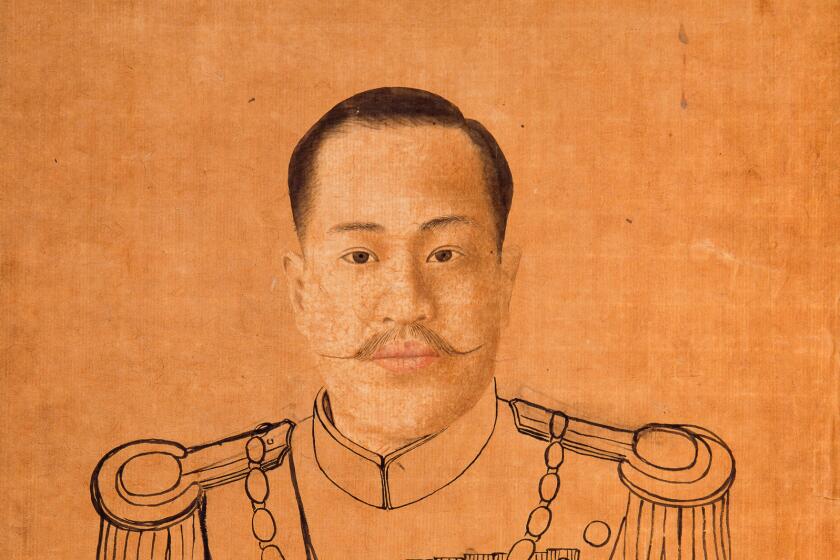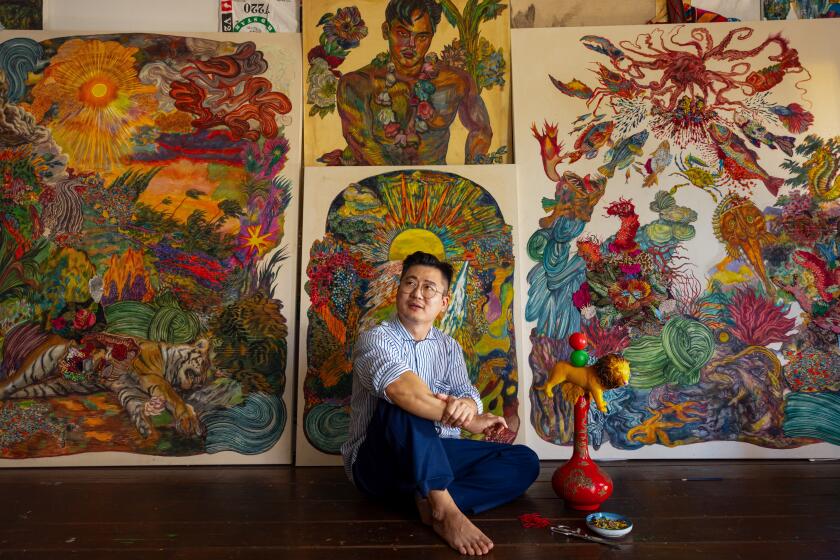Upheaval wrestles with tradition in Korean art of the 1960s and ’70s at the Hammer Museum

- Share via
Seoul is the latest major city to establish itself as a significant international hub for new art. With that distinction comes the expected propagation of ambitious museum exhibitions seeking to articulate, illuminate and cogitate over its local history of modern art, which is little known.
“Only the Young: Experimental Art in Korea, 1960s-1970s” is the latest. It follows “The Space Between: The Modern in Korean Art,” which a year ago covered 1897 to 1965 at the Los Angeles County Museum of Art.
“Only the Young,” organized last year by the Solomon R. Guggenheim Museum in New York, working with Korea’s National Museum of Modern and Contemporary Art, is at the UCLA Hammer Museum in Westwood through May 12. It’s the first show of its kind in North America. With 29 artists and nine artist groups, the exhibition is anchored by varieties of Conceptual art, which became the leading form internationally in the decades under review. The result is work that feels at once recognizable and unfamiliar, which sometimes makes for a bit of a tough haul, if also a nicely curious experience.
“The Space Between: The Modern in Korean Art” is the first major museum survey to examine art produced during a huge cultural transformation in Korea.
The history of the participating Korean museum suggests some of what you’ll find explored in the show. The institution, founded in 1969, smack in the middle of the exhibition timeline, has now branched out into four satellites — Gwacheon, Deoksugung, Cheongju and Seoul, most of them in and around the nation’s capital. Those sites represent shifting centers of power, influence and reigning cultural philosophy within the country, beginning with the isolationist Joseon dynasty that ruled for half a millennium, before the tumultuous modern era.
Of the 29 artists, all but two, Jung Kangja and Lee Hyangmi, are men. That’s one indication of the deep social conservatism of an era of rebuilding after the Korean War, which was led by strongman Park Chung Hee. His tenure — Park took power in a 1961 military coup and was assassinated while still in office in 1979 — brackets the show’s “experimental” era.
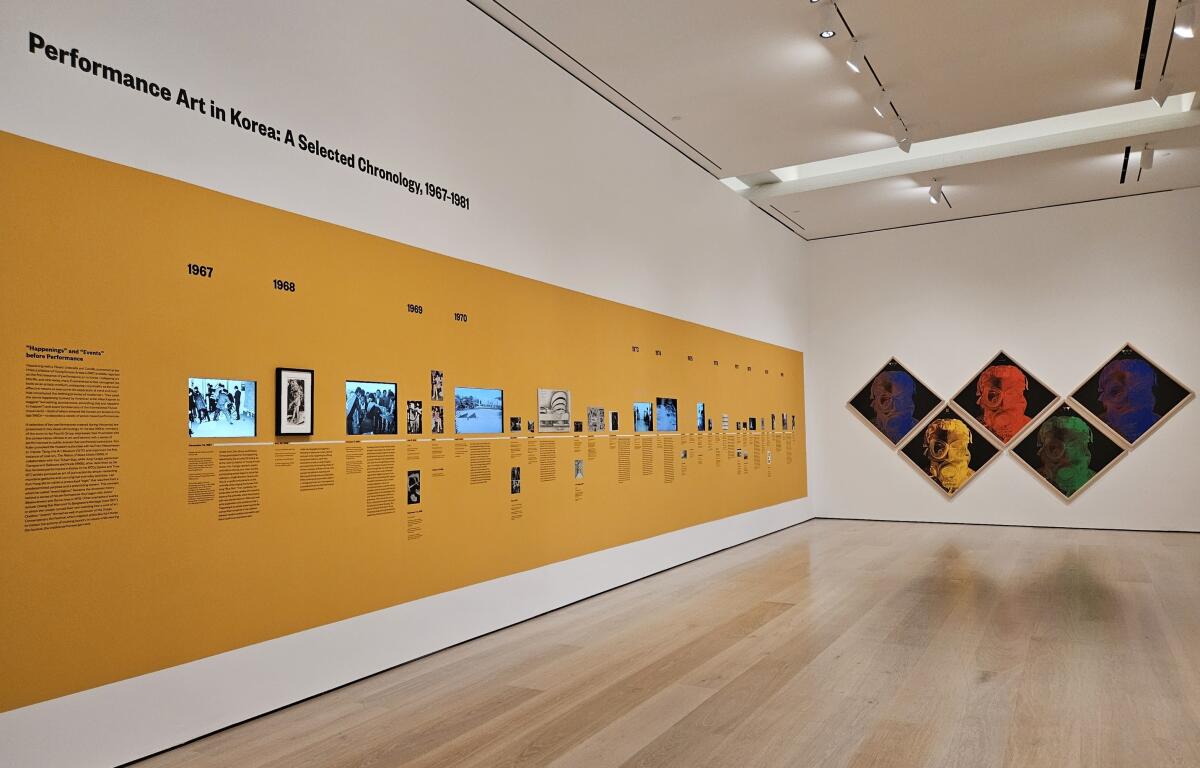
Jung’s participation in a satirical 1968 performance stands out. In a happening that parodied academic female nudes painted by men, her male colleagues, Chung Chanseung and Kang Kukjin, attached transparent balloons to her semi-naked body. The balloons then were popped, one by one, to fully expose the 26-year-old artist.
A hit with their avant-garde coterie, partly for its virtually unprecedented feminist insistence on a living, breathing woman’s centrality to the project, the event didn’t go down well everywhere, including in a scandalized Korean popular press. (Police were also on hand to observe.) Two years later, annoyed authorities shuttered a survey exhibition of Jung’s work.
Painter Ken Gun Min, who mixes oil painting and Korean pigments with collected beads and vintage crystal on raw canvas, reckons with cultural assimilation and identity in L.A.
Jung, Chung and Kang had all been students in the department of Western painting at Seoul’s Hongik University. That such a department existed shows where certain official Asian ambitions lay: The Western establishment was the standard for what “modern” meant. Many young Korean artists worked in groups, affiliated formally or loosely, which may suggest just how minimized experimentation was. (There’s strength in numbers.) Amid churning local political controversies around national identity, the students surely were looking to developments in Europe and the United States for artistic inspiration, with contemporary art magazines as a guide.
At the Hammer, “Transparent Balloons and Nude” is represented by a slightly blurry photograph, displayed with other still and video images of performance art in a helpful timeline that spreads across a wall. The performance indicates obvious debts to slightly earlier Western works.
Among them are Yves Klein’s 1960 performance in Paris, “Anthropometry of the Blue Period,” in which nude women were slathered in blue paint and then imprinted their bodies on canvas; and Yoko Ono’s 1964 “Cut Piece,” first performed in Tokyo and then London and New York (at Carnegie Hall, no less), where she sat alone on a stage while members of the audience were invited to come up and cut off pieces of her clothing. Neither of these cutting-edge Western precedents required police to be in attendance, which yields dramatic — and courageous — resonance for the Koreans’ performance.
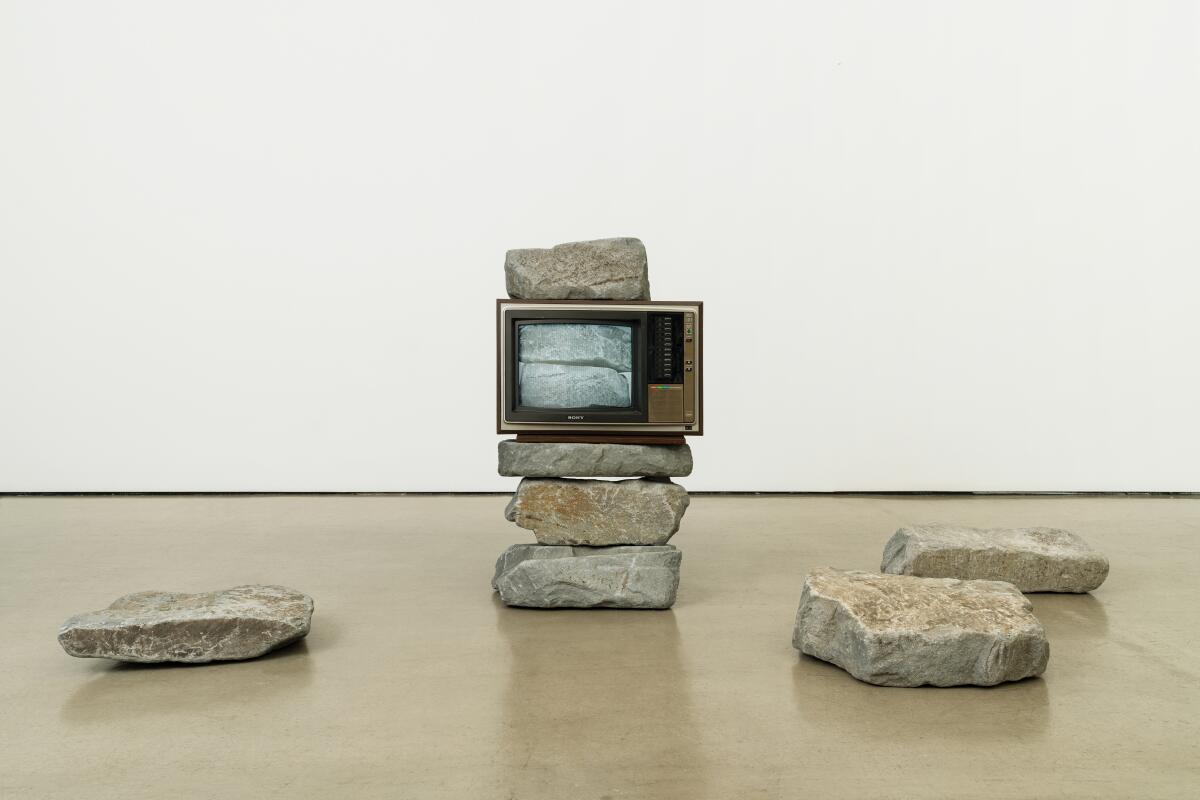
L.A. is home to the largest Korean diaspora, but the country’s history, which may or may not be familiar to Hammer visitors, illuminates what artists were up to. It was not always to profound effect. For instance, Andy Warhol is an obvious marker for Song Burnsoo’s “Take Cover I-V,” five silkscreen images that repeat a gas-masked face, its sequence of solid colors representing coded government alarms related to threats from North Korea. The work’s Pop social commentary is pretty thin.
More intriguing is Park Hyunki’s “Untitled (TV Stone Tower),” which inserts a television monitor within a short stack of hefty stones, surrounded by additional scattered rocks. (Here the show fudges a bit, since the work is dated 1982.) In this Brancusi-inflected “endless column,” commercially produced and ephemeral mass imagery is juxtaposed with an actual, if abbreviated, mass drawn from nature, creating an oddly poignant sense of loss. The effect is only enhanced by learning from the show’s excellent catalog that Park’s composition refers to traditional Korean doltap, stone piles erected at temples to drive away evil spirits.
Two of the show’s simplest works are among its most hauntingly beautiful. Lee Seung-taek’s “Tied Ceramic” and Ha Chong-Hyun’s “Work 73-13” both date from the early 1970s, a time of serious national distress that included ramifications from participation in the Vietnam War.
“Tied Ceramic” leaves the tracks of a rope that, before firing in a kiln, were wound around a white porcelain moon jar, an exquisite traditional form highly revered during the premodern Joseon dynasty. The wrapping marks, cut into the clay like a memory made concrete, oscillate between signs of painful bondage and a warm embrace, a tension both social and artistic in 1970s Korean culture.
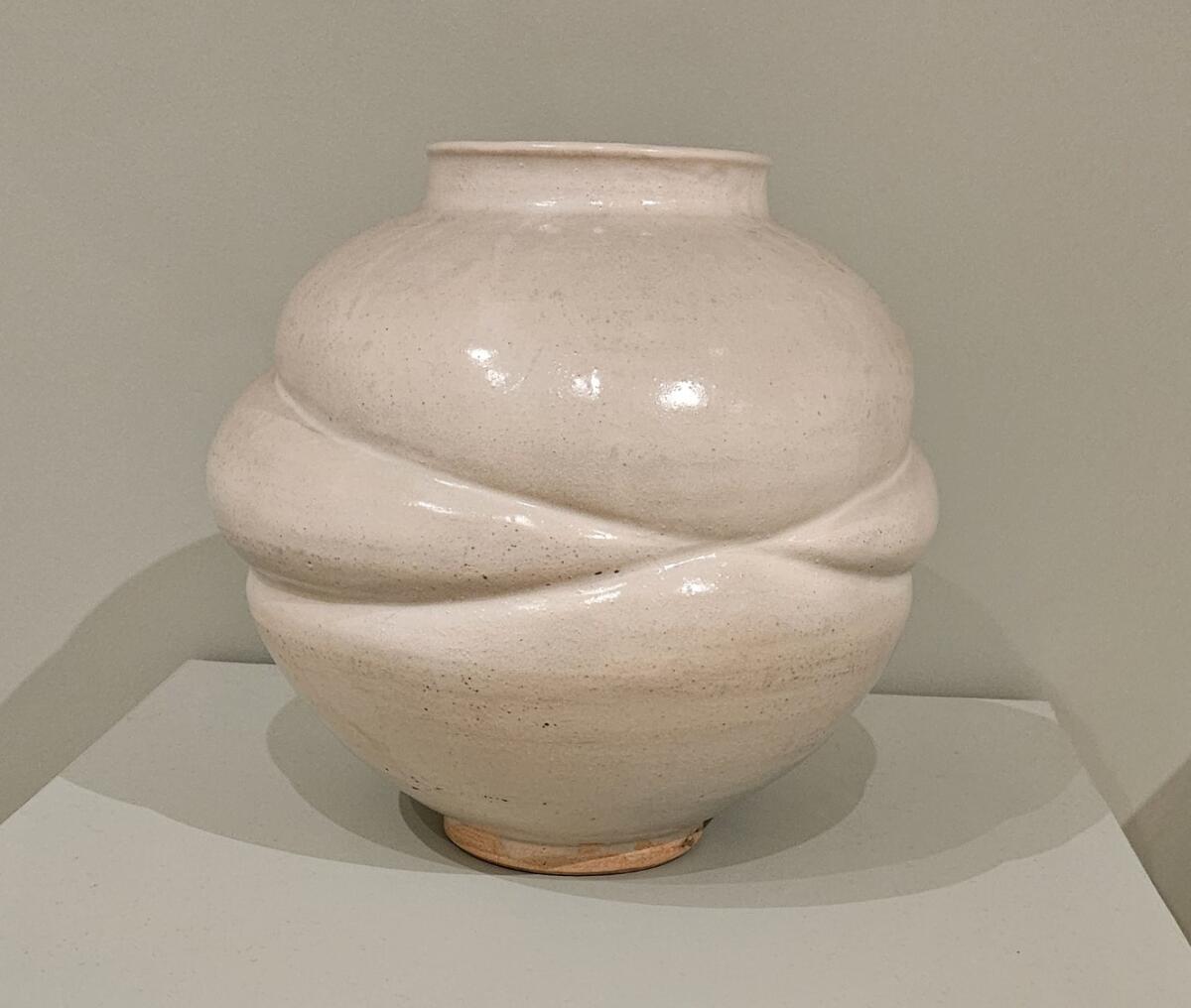
“Work 73-13” is a large, earthy, monochrome abstraction, its mottled muddy color achieved by pushing brown oil paint through rough jute from behind. Almost 4 feet tall and nearly 8 feet wide, the plane is wrapped in a strict grid of barbed wire. The aesthetic effect is of nature, tradition, human effort and modernity imprisoned but unstoppable. It will all ooze out.
A kind of exclamation point marks the final room, where a tall, severed tree stump rises from a big, precisely carved cube made of soil, gravel and concrete. Lee Kun-Yong’s sculpture “Corporal Term,” which sits atop a wooden pallet, is remade whenever it is shown, its natural elements scavenged from local sources. (A Hammer label is careful to note that this particular tangled stump was found as is; no trees were harmed to make the art.) The title “Corporal Term” describes the bodily lifespan of the sculpture, the human effort to fabricate the form, the viewer’s experience of it — even, perhaps, the long arc of Korean history that has brought the object here. The work is a lovely meditation on mortality and endurance.
Kim Kulim, who worked in Los Angeles in the 1990s, emerges from “Only the Young” as an essential artist for the experimental activity that erupted in 1960s Korea. At the show’s entrance, his painting “Death of the Sun II” (1964) is a scarred, all-black panel, made from paint covered with a petroleum-doused vinyl sheet that was set on fire and then smothered. The battered panel — painting as performance art — takes a cue from Shōzō Shimamoto, Saburō Murakami and other Gutai aesthetics of 1950s Japan, which emerged from the apocalyptic ruins of Hiroshima and Nagasaki.
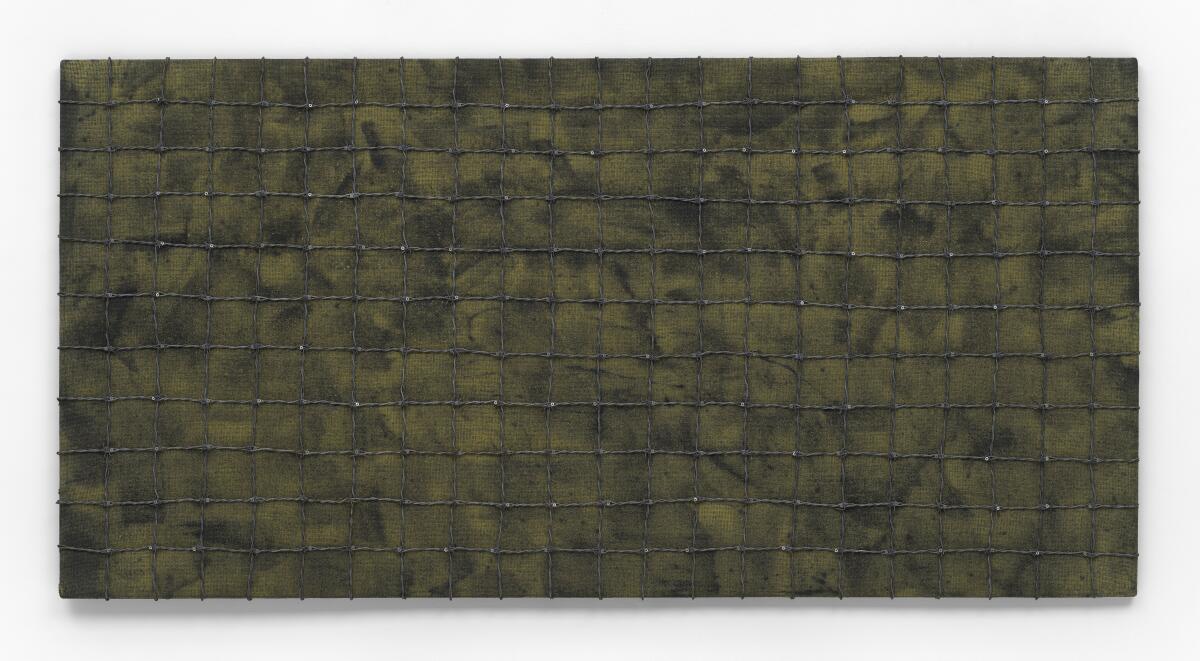
“Death of the Sun II” metaphorically destroys both the revered Korean tradition of black ink painting and modern Western abstraction, whose epitome was said to be the structural void represented by the all-black paintings of 1950s American artists Robert Rauschenberg, Ad Reinhardt, Mark Rothko and Frank Stella. As the show unfolds, Kim turns up in several disparate guises — making films, producing happenings, wiring a big electrified panel of dancing lights — leaving one to wonder what a full solo retrospective might reveal.
Conceptual art was both an extension and a critique of modernism. A common though mistaken assumption is that varieties of Conceptual art erupted in New York and eventually spread out to cover the art globe, as Abstract Expressionist, Pop, Minimal and street art are often erroneously claimed to have done. Rather than representing a cultural center and its periphery, however, the artistic shift in the 20th century’s second half had multiple points of origin all over the globe. Seoul and its environs formed one of them. “Only the Young” does an admirable job of presenting the Korean dialect of Conceptual art’s emergent international language.
'Only the Young: Experimental Art in Korea, 1960s-1970s'
Where: UCLA Hammer Museum, 10899 Wilshire Blvd., Westwood
When: Through May 12. 11 a.m. to 6 p.m. Tuesdays to Sundays, 11 a.m. to 8 p.m. Fridays; closed Mondays
Admission: Free
Info: hammer.ucla.edu, (310) 443-7000
More to Read
The biggest entertainment stories
Get our big stories about Hollywood, film, television, music, arts, culture and more right in your inbox as soon as they publish.
You may occasionally receive promotional content from the Los Angeles Times.
